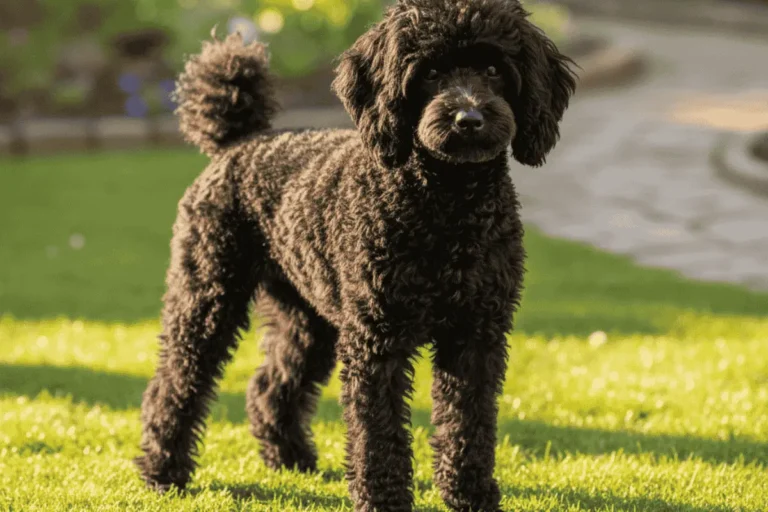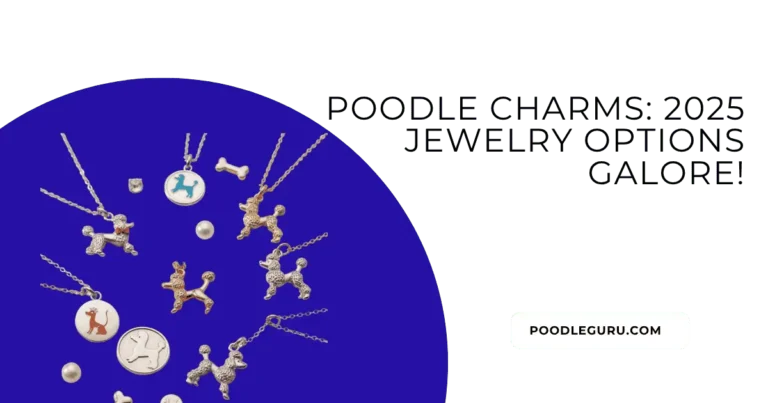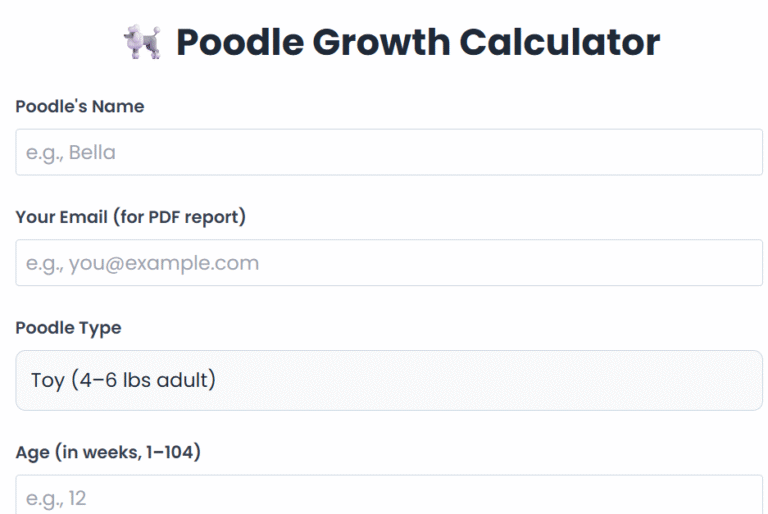Poodles shed far less than the average dog. Their curly coat helps trap loose hair, so there’s less floating around the house. This characteristic makes poodles popular among those seeking a tidier home or mild hypoallergenic treatment. Shedding doesn’t end grooming requirements, however. Poodles require frequent brushing to maintain a tangle-free coat and to prevent mats.
Coat care is poodle life, whether you have a toy, miniature, or standard. Many owners shave their poodle’s coat down to make maintenance easier. In the following sub-sections, get concise truths on do poodles shed so little and pointers on how to care for their fur.
The Shedding Myth
A lot of people seem to think poodles don’t shed at all, but that’s simply not true. All dogs shed, including poodles, and the quantity and frequency of poodle shedding varies. Shedding is natural, and while poodles shed less than most breeds, they still experience seasonal shedding. Due to the nature of their curly hair, the majority of loose hairs remain caught in the curls instead of releasing onto floors or furniture, contributing to their reputation as ‘non-shedding’ dogs. A closer examination reveals a more complex reality.
1. Hair Cycle
Dog hair grows and sheds in three phases: anagen (growth), catagen (transition), and telogen (resting). Poodles, particularly the toy poodles, are in anagen longer, allowing their hair to grow continuously like human hair and resulting in less frequent poodle shedding. In contrast, other breeds with shorter anagen phases, such as Labradors, experience excessive shedding all at once. The duration of each phase significantly impacts shedding tendencies, which is why poodle owners appreciate their unique coat characteristics, as they shed only a few hairs every couple of weeks.
2. Coat Type
Poodles have a single curly coat that functions differently than those of double-coated breeds. Unlike heavy shedders like Huskies, poodles are often considered a hypoallergenic breed due to their unique coat, which lacks an undercoat. The poodle’s curly hair traps shed hair, making daily brushing crucial to prevent mats and tangles. This grooming practice is essential, as loose hair does not shed on its own as quickly as in straight-coated breeds, ensuring a healthy coat for your pup.
3. Shedding Reality
Although poodles are considered a hypoallergenic breed, they do experience poodle shedding. Certain poodles, especially toy poodles, may have a gene that increases their shedding tendencies, making each pup unique. Shedding may fluctuate with seasons, but not as dramatically as in double-coated dogs. Routine grooming and daily brushing keep shedding in check, and most poodle owners find loose hair in brushes rather than around the house. Diet, health, or environmental changes can modify a poodle’s shedding level.
4. Hypoallergenic Truth
There is no such thing as a hypoallergenic breed, even poodles. While poodle shedding is less than in many other dog breeds, they still produce dander, which can be a concern for allergy sufferers. How you respond to a poodle depends on your individual allergies. Regular grooming practices and cleaning the house can significantly reduce allergens. Additionally, poodle mixes, like Labradoodles or Goldendoodles, may not have the same low-shedding coat as pure poodles, leading to inconsistent hypoallergenic qualities.
Puppy Coat Transition
Poodle puppies are born with a fine, almost silky soft baby coat, and unlike many dog breeds, their puppy coat doesn’t shed. Instead, as they mature, their coat transitions to a thick, curly adult coat, which is a slow, months-long affair. This significant shedding phase typically begins between 8 to 12 months of age, depending on the size of your poodle. When their adult coat comes in, it not only changes the texture but also the care required for a healthy coat. The adult poodle coat is both stunning and high-maintenance due to its tighter curl pattern and increased volume, making it essential for poodle owners to adopt proper grooming practices.
Timeline
- Birth to 8 months: Puppy coat is fine, soft, and grows with the puppy.
- 8 to 12 months: Start of coat transition, new adult hairs mix in.
- 12 to 18 months: Most poodles finish the change, adult coat predominates.
- After transition: Grooming needs increase as adult coat matures.
Adult coat growth does NOT equal more shedding. In fact, poodles are known for their low-shedding reputation throughout their lives, as their loose hairs often get caught up in their unique coat curls rather than falling out. This applies to standard, miniature, and toy poodles, although standards may take a bit longer to complete this transition. Monitoring these coat changes is essential for poodle owners to manage grooming demands and prevent matting.
Appearance
As the adult coat comes in, it becomes much denser and curlier compared to what you see on a puppy. This new ensemble implies that daily brushing is essential for maintaining a healthy coat. Neglect your dog’s grooming and mats — those nasty tangles that are hard to remove — can take hold. A neat grown-up coat enhances the poodle’s iconic appearance, accentuating the curls. Occasionally, the coat may shift in color or demonstrate different hues as the puppy matures, showcasing the unique coat characteristics of individual poodles.
Management
Brushing, at least a few times a week, is necessary once the transition begins for poodle owners. A slicker brush and comb are essential for managing poodle shedding and preventing tangles while pulling out trapped hairs. Patience is important, as the transition could take months; every dog’s coat is somewhat unique. Be on the lookout for skin irritation or itching, as the new coat may cause some discomfort, particularly if mats or knots accumulate. Catching these issues early makes them far easier to manage.
Adult Shedding Causes
Adult poodles, particularly the toy poodles, shed significantly less than many dog breeds, thanks to their unique coat structure. Their single coat features a long anagen phase, allowing poodle hair to remain longer on the body. However, poodle owners should note that shedding behavior can increase due to health, diet, stress, or environmental changes.
- Sudden changes in weather or temperature
- Excessive indoor heating or cooling
- Poor indoor air quality from dust or smoke
- Exposure to household chemicals or strong cleaning agents
- Limited access to fresh, clean water
- High levels of pollen or mold in the home
Health
A healthy poodle, especially the hypoallergenic breed, sheds almost nothing. However, if you notice your pup experiencing excessive shedding, health problems could be at play. Hormonal imbalances, like those from thyroid disease, can interfere with the hair growth cycle and hasten loss. Infections—bacterial or fungal—often lead to areas of hair loss, while skin allergies or parasites like fleas can cause scratching and increased shedding behavior. Regular grooming practices, such as daily brushing, can help manage shedding tendencies and maintain a healthy coat.
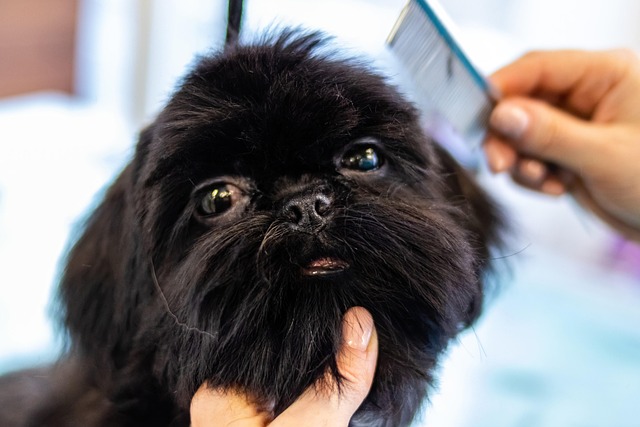
Keep an eye open for red or irritated skin, patches of baldness, or sores. Flaky skin, dull coat, or a sudden change in fur texture may indicate underlying issues. These symptoms suggest it’s time to consult a vet, especially if you have a toy poodle or another shedding breed.
Regular check-ups are essential to catch health issues early. Vets can examine for skin problems, hormonal abnormalities, and infections that might not be noticeable at home. By staying proactive, poodle owners can ensure their canine family member remains healthy and comfortable.
Diet
- Protein
- Omega-3 and omega-6 fatty acids
- Vitamin E
- Zinc
- Biotin
As an aside, a balanced diet is crucial for maintaining a poodle’s healthy coat and reducing poodle shedding. Cheap food often lacks the quality protein necessary for skin and hair health. Opt for dog foods with specific meats as the primary ingredient. Additionally, supplements like salmon or flaxseed oil can help, especially if your pup’s curly hair looks dry or brittle.
Stress
Stress causes poodles to shed more, even if their genes keep typical loss low. Triggers are loud noises, travel or big changes in the home. Look for hiding, decreased playfulness or appetite loss–all of these can be stress indicators.
Provide your poodle with a calm environment, maintain consistency, and apply soft hands. Significant lifestyle changes, such as moving or acquiring new animals can increase stress and result in increased shedding.
Environment
Indoor weather counts. High heat or low humidity can dry out skin, leading to increased hair loss. Allergies—like dust mites, pollen, or mold—can increase shedding.
Wash floors and linens frequently. Washing toys and bowls to reduce dander. Air purifiers take the airborne particles out, which makes the environment safer for both pets and those with allergies.
Grooming Imperatives
Poodles don’t shed a lot, but their distinctive curly hair requires regular maintenance. Regular grooming prevents their coat from matting and tangling, which can be painful and lead to skin problems. The right arsenal—think coat brushes, deshedding tools, nail trimmers, and wipes—is essential for maintaining a healthy coat. Daily brushing not only distributes natural oils but also helps keep the coat glossy and soft.
More importantly, many poodle owners swear these routines minimize shedding and establish an unbreakable connection between pet and pet owner. While we can manage some grooming at home, for more complicated cuts and styles, we often need professional groomer assistance.
Brushing
Brush a poodle 2 or 3 times a week to prevent mats before they begin. This is more than aesthetic — mats tug on the skin and may result in infections or sores, so consistent brushing is a health necessity, not merely an option.
Use a slicker brush or a curly coat comb. These tools help penetrate deep into the fur and eliminate loose hair and debris. Steer clear of straight-haired breed brushes, as they won’t get through the curls.
Begin brushing at the legs and brush your way up, in small sections. This ensures you don’t skip over spots and allows you to inspect for concealed tangles. Brushing distributes skin oils as well, which maintains coat softness and reduces tangling. Be consistent with this routine to maintain your poodle’s coat.
Bathing
Bathing once a month with a mild, poodle-specialty shampoo is sufficient for the majority of poodles. More baths can dry out their skin, less often can allow dirt to accumulate and damage skin health.
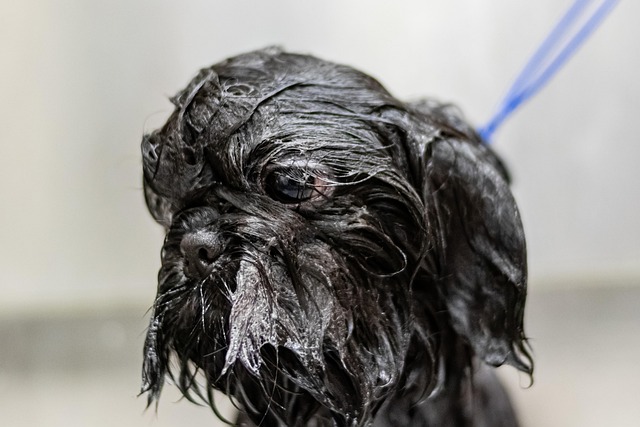
Be sure to wash out all of the shampoo and always finish off with a light conditioner. Conditioners keep the coat soft and static-free, thus easing brushing later on. Take lukewarm showers and make sure that you don’t get water in your ears to avoid infections.
Inspect their skin for redness, bumps or flakes at bath time. By noticing changes early, you can act quickly if there’s a problem.
Clipping
Frequent clipping maintains a poodle’s coat at a secure, comfortable length. If allowed to grow their fur will matt and camouflage dirt which can lead to skin issues. That’s why most owners pick up at least basic trim skills.
Professional groomers are great for special styles or if you need a tidy, even appearance. Poodle cuts vary by fashion and purpose—opt for styles like the puppy clip for low maintenance, or the continental clip for exhibition. Clipping eliminates aged, loose hair, reducing the little bit of shedding poodles do have.
Be in the know about fresh grooming tips and styles. It assists you discover what works best for your dog and prevents grooming from becoming monotonous.
The “Doodle” Factor
Poodle mixes, commonly known as “doodles,” are infamous for their selection of coat types and shedding levels. A “doodle” refers to the hybrid of poodle characteristics with another breed, resulting in significant variability, even among litter mates. The coat may be curly, wavy, or straight, influenced by the blend of genes from both parent breeds. For instance, a Goldendoodle could have a loose wavy coat, while a Labradoodle might feature a tighter curl or a straight coat. Understanding poodle shedding tendencies is crucial for potential owners.
The extent of shedding in a doodle is largely dependent on genetics, which can be unpredictable. The primary genes at play, such as the MC5R and RSPO2, affect the coat’s appearance and the amount of shedding. The “furnishings allele” (F allele) gives doodles their trademark facial hair and wirly/curly coat. Some doodles shed so minimally that they appear to be an ideal choice for allergy sufferers, making them popular among those seeking hypoallergenic dogs. However, even low-shedding doodles aren’t 100% hypoallergenic, as dander can still be emitted from their skin.
Grooming requirements vary significantly based on shedding behaviors. Doodles with curlier coats tend to shed less but require more maintenance to prevent matting and tangling. In contrast, straight-coated doodles may shed more but require less frequent brushing. Most doodles will need regular brushing—potentially a few times a week—and grooming sessions every few months. Neglecting grooming can lead to painful mats, particularly behind the ears and under the legs, impacting the overall coat condition.
Potential owners need to know what they’re getting into and research the particular doodle mix they’re interested in. From one breed mix alone, grooming and shedding requirements can vary significantly. Talking to breeders, trainers or groomers can set real expectations. The more poodle-esque dogs shed less, but their coats are a bit more maintenance. Doodles require training, social time and daily exercise to be happy and well-behaved.
Coat Health Indicators
A healthy poodle coat is unmistakable. The coat is soft to the touch, has a distinct shine, and minimal shedding, making it an ideal choice for dog owners looking for hypoallergenic breeds. The curl and texture are derived from the RSPO2 gene, which forms the mustaches and tight curls found in poodles. Dogs with at least one F allele in this gene nearly always have a curly coat.
Genes such as MC5R determine shedding levels in dogs, while FGF5 controls the length of the coat and KRT71 influences curl formation. Poodles tend to shed less than many other dog breeds, particularly the SD/SD and F/F, and SD/N and F/F types, making them a popular choice among poodle owners.
The coat’s shine is critical for poodle health. A shiny, uniform coat indicates that the skin is probably healthy and the dog’s nutrition suits its requirements. Light shedding is normal for poodles, but if you notice excessive shedding or fur balls on the ground or brush, it may signal an issue. The hair growth cycle has three main steps: anagen, catagen, and telogen. Anagen is when hair grows, lasting longer in poodles, resulting in consistent but slow growth and less shedding overall.
Dull or dry fur is a red flag for poodle owners. If the coat lacks luster, is coarse, or appears splotchy, this may indicate conditions such as malnutrition, allergies, or skin infections. Stress or sickness may alter shedding behavior. If a low-shedding poodle suddenly begins to lose more hair, it could be responding to environmental changes or combating disease, raising concerns for sensitive families.
Regular inspections of the coat are crucial for maintaining a healthy poodle. Run your hand through the coat once a week to detect any abnormalities in texture or density. Check for mats, tangles, or dry spots. If you detect a change, a trip to the vet might be in order. Early checks help find health issues before they flare. Basic proactive measures such as daily brushing to prevent tangles, checking for coat shine, and monitoring shedding patterns are all excellent indicators to keep your poodle healthy and comfortable.
Conclusion
Poodles shed less than most breeds, but no dog is completely shed-free. Young pups shed their baby coat. Adult poodles do drop some hair here and there, primarily with ill health or neglect. Good brushing keeps the coat neat and reduces loose hair. Mixed poodle breeds can shed more or less hair, so it’s worth it to look at the parent breeds.
A glossy, abundant coat usually equals a healthy dog. Being on top of grooming and checking for health issues keeps shedding low. For obvious advice or assistance, consult a groomer or your veterinarian. Want to know more or share stories? Come share your poodle stories in our pet care chat.
Frequently Asked Questions
Do poodles shed hair?
Poodles, known for their unique coat, shed less than most dog breeds. Their curly hair traps loose hair, minimizing shedding around your home.
Why do some people think poodles do not shed at all?
Poodles are often considered a hypoallergenic breed because their unique coat prevents loose hairs from falling out. However, regular grooming is essential to maintain a healthy coat and eliminate poodle shedding.
Does a poodle puppy shed differently from an adult?
Yes. Poodle puppies have a soft coat which they shed when they mature their adult coat, typically between 6-12 months of age.
Can health issues cause a poodle to shed more?
Yes, health issues such as allergies, stress, or malnutrition can exacerbate shedding tendencies in poodles. If you observe abnormal poodle shedding, see a vet.
How often should I groom my poodle to control shedding?
Regular brushing, at minimum two to three times per week, helps manage poodle shedding by removing loose hairs and preventing tangles. Professional grooming every 4-6 weeks is advised for optimal coat condition.
Do poodle mixes (“doodles”) also shed less?
Most poodle mixes, known as “doodles,” are often considered hypoallergenic breeds with lower poodle shedding, but shedding variance exists depending on their other parent’s traits.
What are signs of a healthy poodle coat?
Your poodle’s coat, whether it’s a toy poodle or a standard poodle, should feel soft, dense, and springy when healthy, reflecting the unique coat condition of hypoallergenic breeds.

